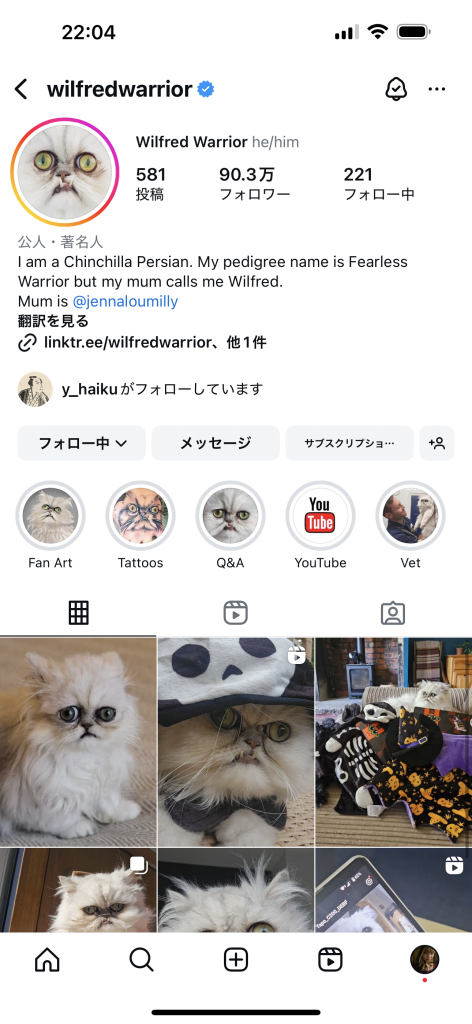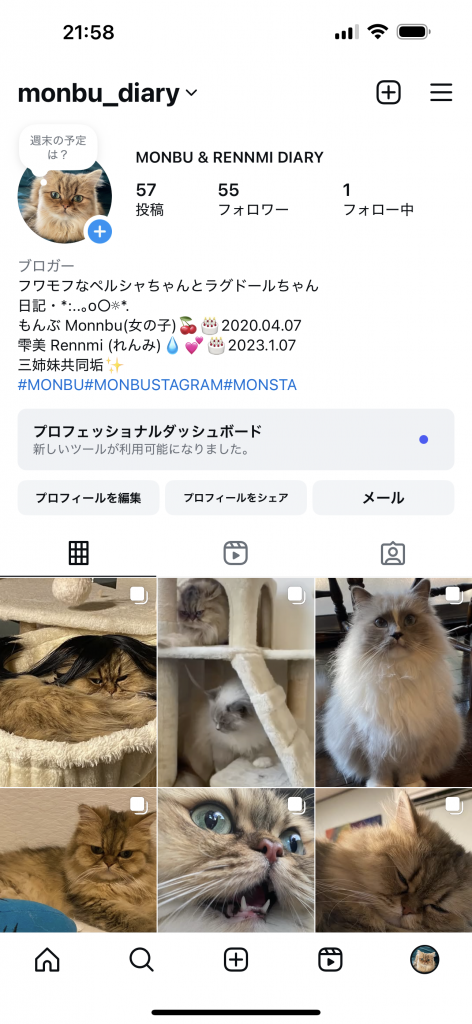
The Rise of Pet Influencers
As a cat lover myself, I sometimes enjoy watching funny cat videos and sharing them with my sisters in our group chat. I have two cats back in Japan, and I miss them so much. The topic of pet Influencers came to mind when I was thinking about this week’s blog. It’s such an interesting phenomenon—that people post about their pets as if they can talk, think, and act like humans.
When I searched ”Pet social media account ”on YouTube, I found one a video, “How To Make Your CAT Famous! (Step-by-Step Guide)”. I was surprised by the words the woman in the video described. She began by saying, “So, you want your cat to be famous? How does this work? How do I make money? Let’s do this, right? ” I felt it was one kind of extreme consumption.
However, I soon realized that I also created an Instagram account for my cats. Even though I strongly didn’t want them to be famous, I wish deep down that my cat’s Instagram might become famous someday, like the content I had seen online. At first, I disagreed with the woman in the video, but when I looked back at my cats’ Instagram account, I began to understand why people want their pets to be famous. What is the reason for making a pet account? Why is Instagram a popular platform for it?
Why Do People Want Their Pets to Be Famous?
Why do we want our pets to be famous on social media? Perhaps we can look at this from three aspects. First, there are emotional reasons. We love our pets, feel proud of them, and want to share that joy with others. Second, there’s social validation— likes, followers, and comments encourage us to stay active online. The more engagement we receive, the more we feel that others recognize our pets’ cuteness. Finally, Financial motivation. Sponsorships, ads, and brand collaborations can turn pet posts into real income. Many owners might have started by posting just for fun, but once their pet’s videos gain attention, they can become a small business.

My Own Cat Account
Before I share my thoughts further, let me introduce my two cats and our Instagram account, which I manage with my sisters. Even though we only have 55 followers(mostly friends and family), I really enjoy creating posts and short videos.
When we post content, we use hashtags in Japanese, Korean, and English. For example, in English, #Catslovers, #catsagram, and #Nyangstagram(which means “meowstagram” in Japanese).
At first, I denied that I cared about popularity. But looking back, adding hashtags and captions as if my cats were talking like humans shows that, in some way, I did want them to be noticed. Maybe I, too, was trying to make my cats “famous” on Instagram.
Anthropomorphizing the Cat

One fascinating aspect of cat content is how we tend to give human traits to our pets. One of my favorite cat accounts, Wilfred Warrior, is a famous example. Another is the Korean influencer Korean influencer Underworld, who playfully acts as a “boss” while his cats appear as “workers”.
Communication researcher Felix M. Simon calls it “Anthropomorphizing the Cat.” He explains that humans naturally ascribe human attributes to animals. Cognitive scientist Alexandra Horowitz adds that anthropomorphism began as a perceptual tool that helped our ancestors make sense of a complex world.
Horowitz also notes that the more an animal resembles a human in appearance or expression, the more likely we are to anthropomorphize it. Expressive faces, gestures, and eye contact trigger that tendency, and cats score high in all of these areas.
Choosing the Right Platform
Pet content isn’t limited to Instagram— it thrives on YouTube, Facebook, TikTok, and X/Twitter. The woman in the YouTube video emphasizes that it’s crucial to choose the right platform, since each one has its own audience and rhythm. For instance, Instagram is perfect for cute or aesthetic photos. Facebook appeals more to older audiences and is great for community-building, though its algorithm changes frequently. TikTok focuses on short, funny videos, and YouTube works well for longer storytelling. She also mentioned that “to stay visible, you need to post almost every day — even their pets start to have work schedules.”
In the end, the rise of pet influencers shows how deeply humans want to connect — not only with their pets, but with each other. Whether it’s love, attention, or income, every post reveals something about our relationship with animals in the digital age. Maybe we’re not just making our pets famous; we’re also using them to express our own emotions, humor, and desire to be seen.
Sources:
https://felixsimon.medium.com/rich-cats-of-instagram-814e32a509eb


It’s kinda great to think that pets are so universal that they have such power to connect people from all over the globe. And even though they have this universality, they are all different and have a unique relationship with various people.
This also reminds me of those movies with talking animals. If only we knew how they think and what their opinions are.
First I have to start by saying that I am also a cat lover, and I greatly appreciate the number of cat pictures in this blog.
I also wanted to have a cat account or a while, for the reasons you share, and also in a way to have a more open platform (as I have a private account) where opinions I expressed could be spread further. But in retrospect I am glad I didn’t do this because it would be strange to have a ‘cat’ sharing my views on different subjects. It feels like I would be hiding behind a mask. I feel like the same issues arise with making money off of the accounts I suppose. So I guess its better to keep it to just cute and funny videos for now.
When we really think about it, people’s desire to monetize everything with the use of digital is becoming scary. Funny cat videos to me were always a source of bonding content, because even a dog person will appreciate them. Furthermore, this phenomenon of anthropomorphism and that makes us laugh at the video is really interesting, or we can also relate to the owner. As you mention, people who decide to share their pet and gain visibility may be doing it because of their personal need for recognition. I believe that unless they are hurting or forcing those animals to get bigger clout, it is a fun trend that shows how animals can be an entertaining part of our lives just by being themselves.
First of all, your blog is so well written! I really enjoyed the numerous cat pictures during my study session. The way internet users interact with pets online is indeed very interesting. These cute creatures with no opinions on any social and political matters are very appealing to the majority of people (myself included). Who doesn’t like such adorable beings? Considering that, it is a very easy way of monetizing your accounts, since it can rarely go against community guidelines and can quickly gather a bunch of interactions. It is actually a common practice, a lot of people create random accounts about pets and post compilations of cute videos to get money from them, and they might not even own a pet! Every time I like a tiktok of cute bunnies I know I’m giving money to someone haha but I can’t stop because they make me so happy! I have come across advertising agencies focused only on pets and it makes me wonder if people are taking good care of their animals or just getting them as a tool to make more money.